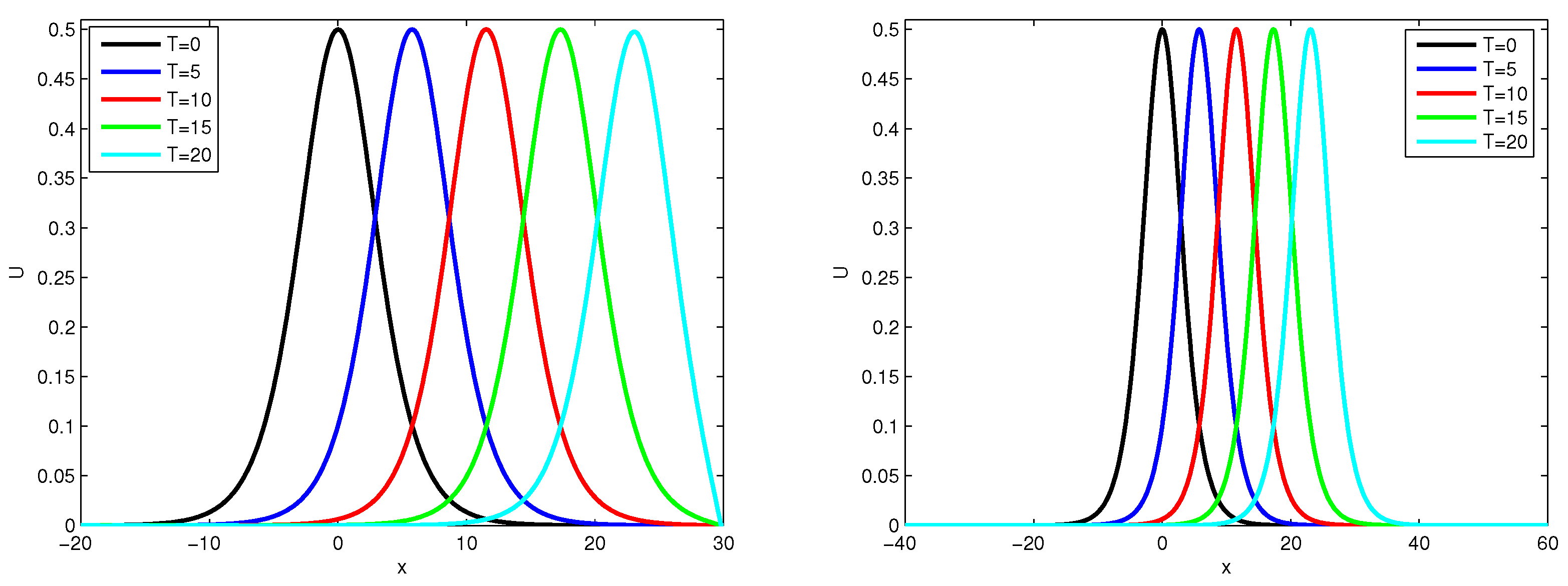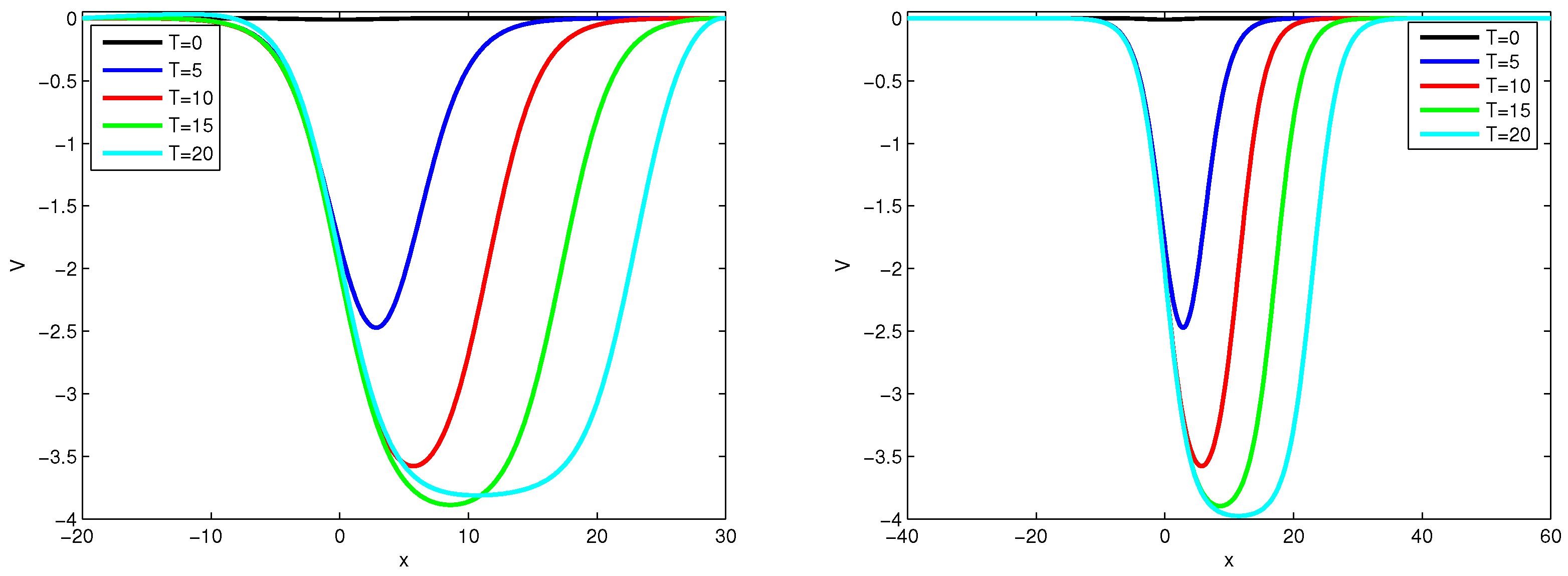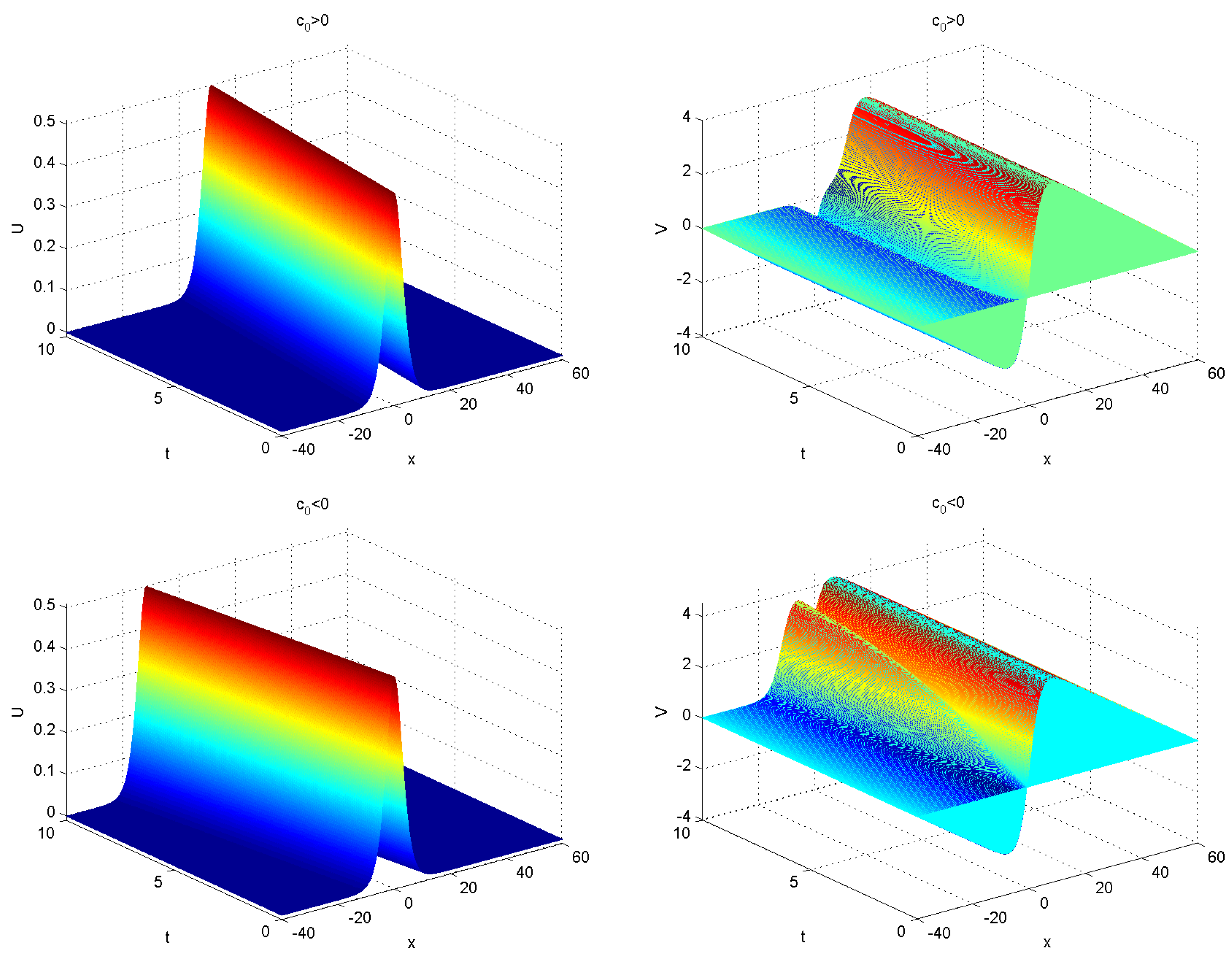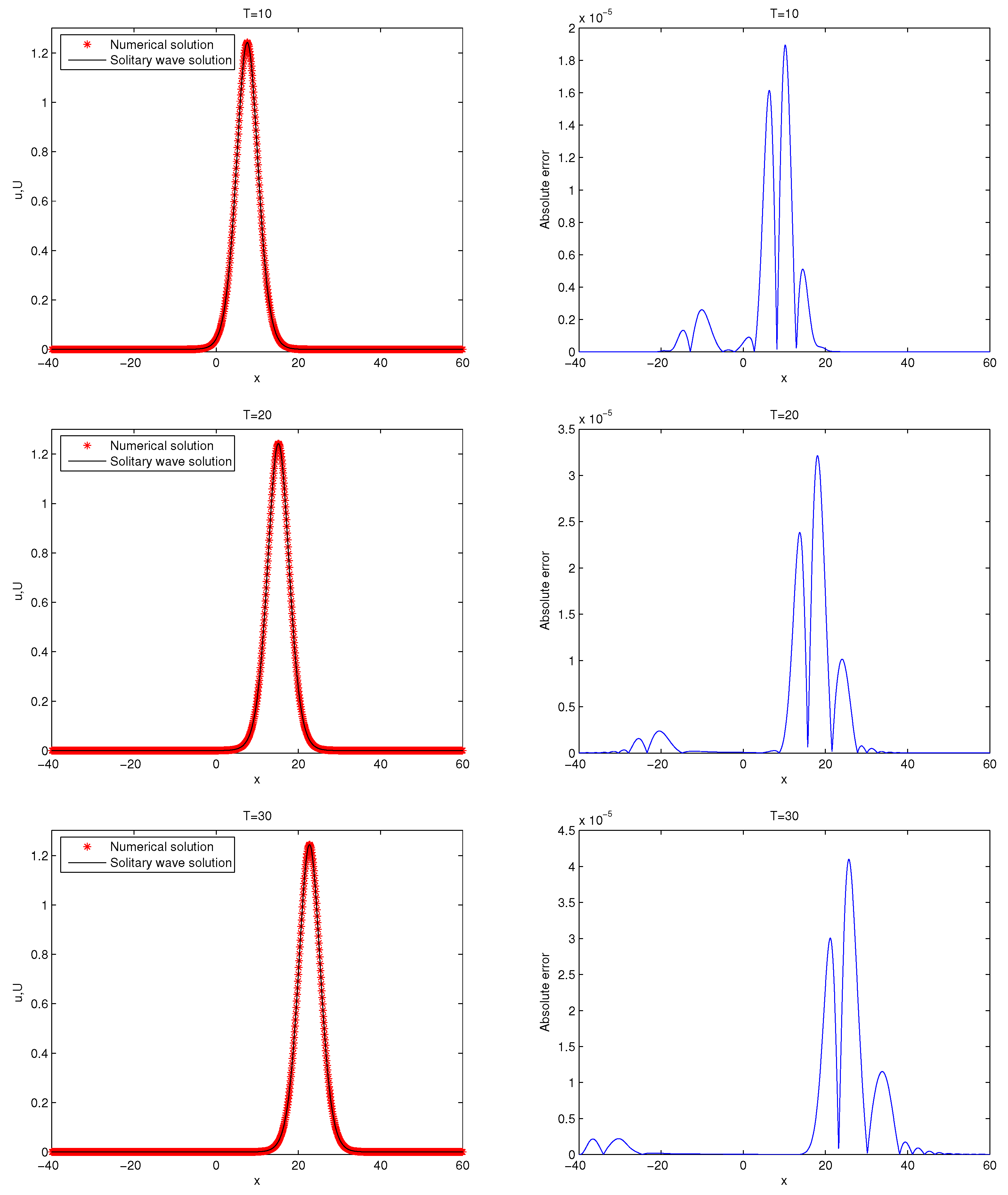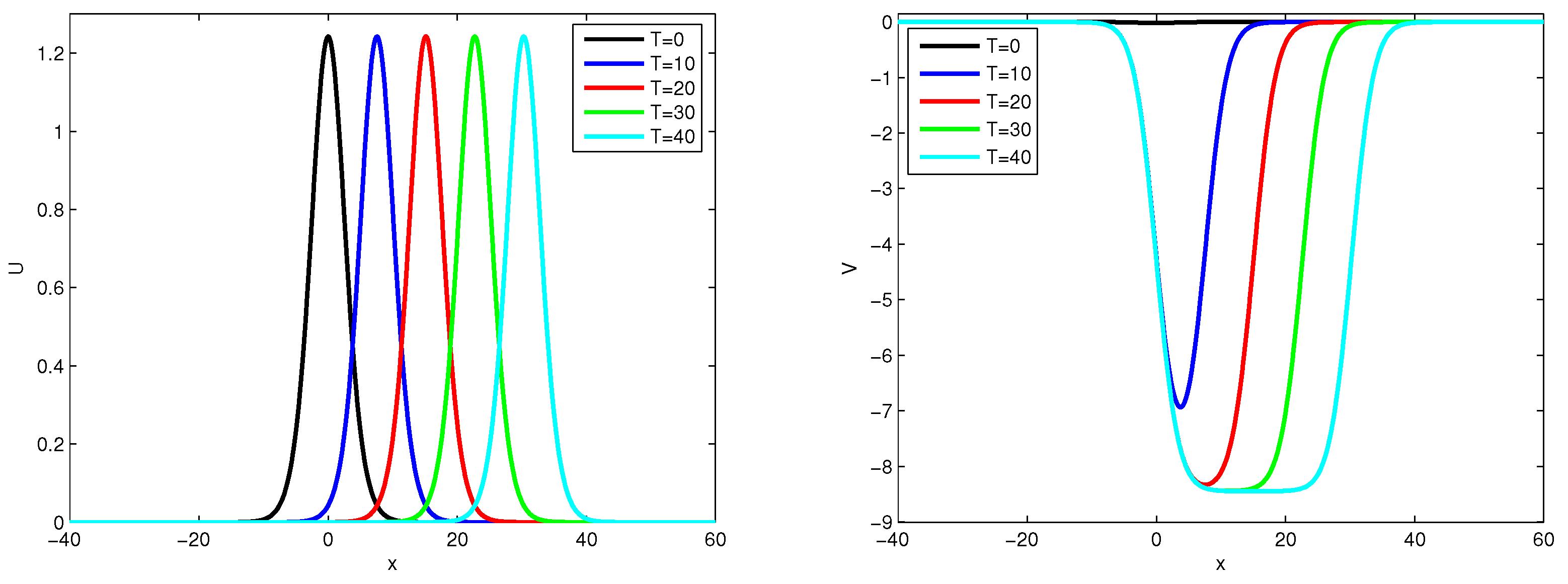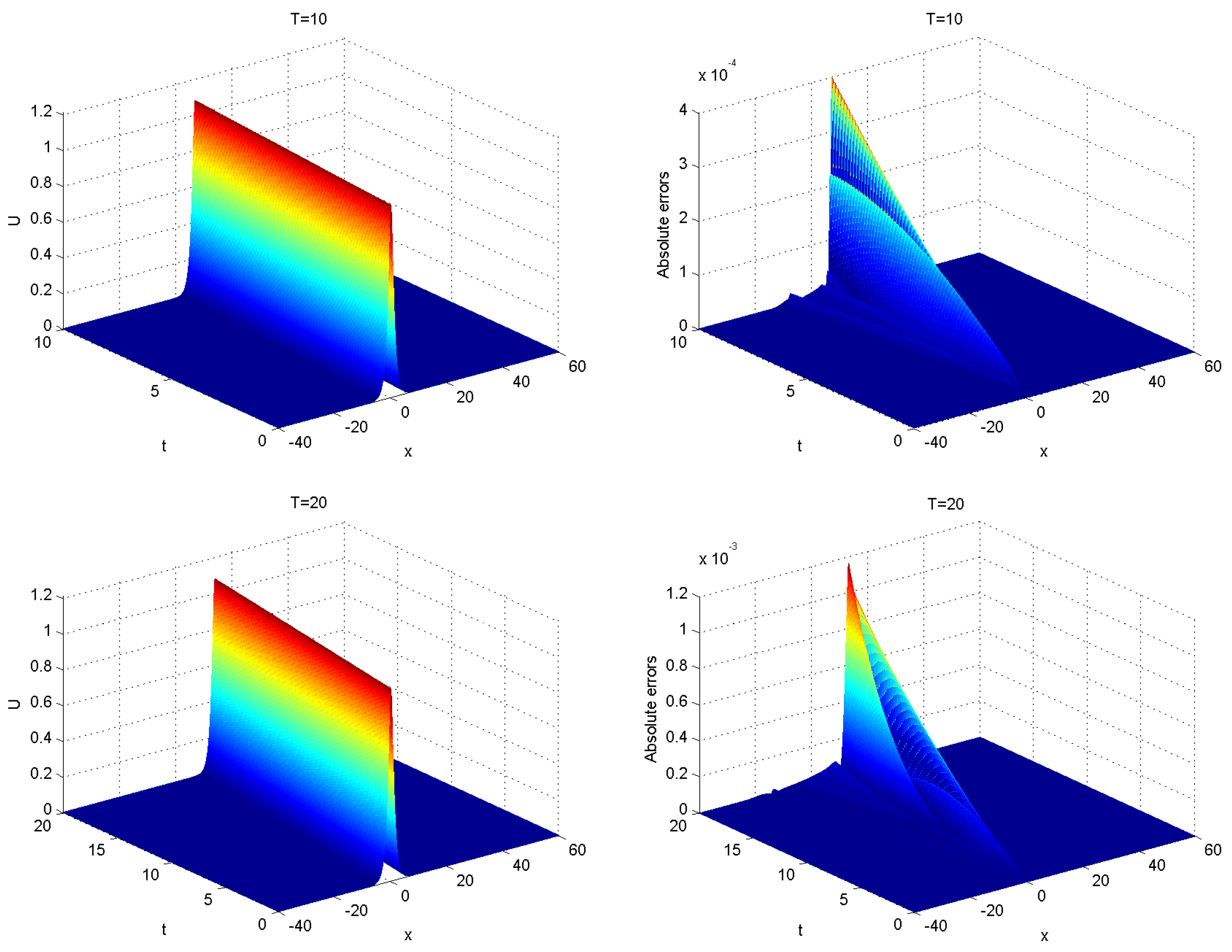1. Introduction
The numerical solution of partial differential equations (PDEs) is a fundamental component in numerous scientific and engineering applications. In recent years, there has been a growing emphasis on developing high-order finite difference methods to improve both the accuracy and efficiency of solutions for a wide range of PDEs. A particular area of interest is the Boussinesq equation, which was first introduced by Joseph Boussinesq in 1872 to model nonlinear wave propagation in dispersive media [
1]. Consequently, this equation has been extensively applied across multiple domains, including the investigation of ion sound waves in plasma, solitary waves in vascular systems, tsunami waves in oceanography and coastal sciences, as well as pressure waves in liquid–gas bubble mixtures, among others [
2,
3].
This article investigates the sixth-order Boussinesq equation, taking into account the effects of surface tension, as outlined in the following [
4]:
with the specified initial conditions
where the parameters
,
,
, and
are non-negative, while
k and
c are constants. Furthermore,
is a positive integer, and
and
are two provided smooth functions.
Solitary waves have attracted considerable interest in various fields of physics and engineering. Biswas [
5] successfully derived an exact solitary wave solution for the Korteweg–de Vries equation, which is characterized by power law nonlinearity and time-varying coefficients. The singular solitary wave solution for the Rosenau–KdV equation is presented in [
6], while a specific 1-soliton solution for the Rosenau–KdV RLW equation is detailed in [
7]. Equation (
1) is frequently encountered in numerous mathematical models concerning solitary wave propagation, as emphasized by Lu and Helal [
8,
9]. Furthermore, Biswas et al. [
4] provided a variety of solitary wave, shock wave, and singular solitary wave solutions for the Boussinesq Equation (
1), incorporating the effects of surface tension. Under the assumption of solitary wave behavior, it is observed that the solution to the sixth-order Boussinesq equation (
1) and its derivatives approaches zero as
, as noted by Burde and Yimnet et al. [
10,
11]
Thus, Equation (
1) is linked to the following global conservation law:
This research focuses on the solitary wave solution and aims to develop a conservative linear finite difference scheme for the sixth-order Boussinesq Equation (
1). To implement the numerical method effectively, we analyze a sufficiently large yet finite spatial domain, denoted as
, instead of the unbounded interval
. This ensures that the solution remains sufficiently small at the domain boundaries. Consequently, we consider the following boundary conditions:
where
. Considering the requirement for continuity, we further assume
.
The Boussinesq equation and its variants have been extensively studied through both theoretical and numerical methods. Esfahani and Farah [
12] investigated the following nonlinear sixth-order Boussinesq equation in the theoretical context:
The authors established the local well-posedness of Equation (
4) within the framework of non-homogeneous Sobolev spaces
, where
and
. Subsequently, Wang and Esfahani [
13] conducted an investigation into the sixth-order Boussinesq equation as follows:
They demonstrated that the problem described by Equation (
5) is globally well-posed within the Sobolev space
, where
and
.
In a numerical context, Feng et al. [
14] proposed a symmetric three-level implicit difference scheme that exhibits second-order accuracy for the following sixth-order Boussinesq equation
A linearized stability analysis indicates that the difference scheme, which incorporates a free parameter denoted as
, exhibits stability for values of
that are equal to or greater than 1/4. In 2017, Kolkovska and Vucheva [
15] introduced a nonlinear second-order difference scheme aimed at addressing the sixth-order Boussinesq problem, as detailed below:
However, the scheme presented in [
15] demonstrates conditional stability, which is dependent on a strict limitation on the subsequent ratio
Moreover, there is a significant lack of theoretical analysis regarding the solvability and convergence properties of the scheme proposed by Kolkovska [
15]. Recently, Arslan [
16] introduced a novel methodology combining the differential transform method with the finite difference technique to approximate solutions for singularly perturbed ill-posed problems and sixth-order Boussinesq equations. In another study, Zhang et al. [
17] introduced a meshless numerical technique called the generalized finite difference method, which has proven effective for solving enhanced Boussinesq-type equations, especially for simulating wave propagation over irregular bottom topographies.
In numerical simulations, compact difference schemes generally require fewer stencils than standard finite difference methods while providing better resolution and maintaining the same order of accuracy. Hou et al. [
18] introduced an energy-preserving, high-order compact finite difference scheme specifically designed for two-dimensional nonlinear wave equations. Mohanty et al. [
19,
20,
21,
22] developed highly accurate compact difference schemes for several equations, including the coupled viscous Burgers equations, the good Boussinesq equation, the time-dependent viscous Burgers–Huxley equation, and a generalized version of fourth-order parabolic partial differential equations.
On the other hand, the principle of conservation of mass and energy is crucial in physics. A numerical scheme that fails to uphold local conservation may produce non-physical outcomes [
23]. Therefore, preserving mass and energy is fundamental in the development of numerical schemes for solving PDEs. Significant research has been conducted on conservative finite difference schemes for various nonlinear wave equations. For instance, Deng et al. [
24] proposed energy-preserving finite difference methods for two-dimensional nonlinear wave equations. Bayarassou et al. [
25] investigated a high-order conservative linearized finite difference scheme for the regularized long wave (RLW) Korteweg–de Vries equation. Additionally, Nanta et al. [
26] presented a wave model integrating the classical Camassa–Holm equation with the BBM–KdV equation, incorporating dual-power law nonlinearities while ensuring energy conservation.
This article aims to present a conservative difference scheme for solving the sixth-order Boussinesq problem as defined in Equations (
1)–(
3). Additional, it will examine the solvability, convergence, and stability of the proposed scheme.
Theorem 1. Consider u as the solution to the sixth-order Boussinesq problem defined by Equations (1)–(3). Let us denote and assume that the supplementary boundary conditions are provided by and . Under these conditions, it can be concluded that for all , where Proof. Let
. We substitute this expression into Equation (
1) and subsequently take the antiderivative twice. This process results in the following equation:
we the obtain
Utilizing the boundary conditions delineated in Equation (
3) along with the additional assumptions, we derive the following results
Consequently, from Equations (
8)–(
12), we deduce that
, which indicates that
for
. This completes the proof. □
It is essential to emphasize that, if parameters
,
,
,
,
k, and
c and the initial conditions
and
satisfy
, then
can be defined as the energy, and the solution to Equations (
1)–(
3) complies with the principle of energy conservation, where
The remainder of this article is organized as follows.
Section 2 introduces a compact finite difference scheme for solving the sixth-order Boussinesq Equations (
1)–(
3).
Section 3 rigorously establishes the discrete conservation properties of mass change rate and energy. A comprehensive theoretical analysis addressing the scheme’s solvability, convergence, and stability is presented in
Section 4. Numerical experiments validating the theoretical results are included in
Section 5. Finally,
Section 6 provides a concise summary of the findings.
2. Compact Difference Scheme
In this section, we present a compact and conservative difference scheme to solve the sixth-order Boussinesq problem as delineated in Equations (
1)–(
3). For two positive integers
J and
N, we define the spatial and temporal discretization parameters as
and
, respectively. The uniform grid points are established as
and
, where
and
. We denote
as the approximation of the function
u at the point
and
where
. The Sobolev space is defined as described in [
27]:
For any two mesh functions
, we define the following difference operators, inner product and norms:
By setting
then Equation (
1) can be expressed as
. By utilizing the Taylor expansion for the variable
x, we obtain
Furthermore, Equation (2) is associated with
Substituting Equation (
15) into Equation (
14) yields
By applying second-order accuracy in our approximations, we achieve
Consequently, the proposed compact finite difference scheme can be expressed as follows:
It is essential to recognize that, since , , and hold based on Equation (18), we may proceed with the assumption that for the sake of simplicity. Similarly, we can also assume that , where , and denote ghost points under the condition . Consequently, it can be concluded that .
In this context, we employ the following methodology to derive
:
From Equation (17), we obtain
that is,
which yields
where
.
5. Numerical Experiments
In this section, we conduct a series of numerical experiments aimed at assessing the efficacy and accuracy of the theoretical analysis presented in the preceding sections. Following this, we will quantify the corresponding errors utilizing the designated error norms [
31,
33,
35]:
Example 1. Consider the parameterswhich is the following improved Boussinesq equation [2,31]and the solitary wave solution is expressed as followswhere A, , and are provided constants. The initial conditions may be established by evaluating Equation (76) and its derivative for t at the point : First, we choose the following parameters:
and compare our findings with the numerical results presented in [
2]. The computational accuracy for both temporal and spatial variables is evaluated at
and is detailed in
Table 1 and
Table 2, where
in
Table 1 and
in
Table 2. The data in
Table 1 and
Table 2 indicate that the current difference scheme (16)–(18) significantly outperforms the finite volume element scheme described in [
2].
On the other hand, to further demonstrate the computational efficiency of the proposed compact difference scheme (16)–(18), we compare the numerical errors with the previous studies [
3,
36,
37]. The results are detailed in
Table 3, where the error is defined as follows
It is evident that, under the same conditions, the computational errors of the proposed difference scheme (16)–(18) are smaller than those reported in other studies.
The present analysis investigates the solitary wave and its corresponding numerical solutions, as illustrated in
Figure 1. The spatial domain is defined as
and
, with parameters set at
and
at the time instances
.
Figure 1 indicates that the patterns generated by the current scheme (16)–(18), demonstrate a significant degree of agreement with the solitary wave solutions.
Furthermore, the numerical solutions for the auxiliary variable
, as estimated by Equation (
21), are visually represented in
Figure 2. The graphs displaying the approximate solutions
and
, obtained from the difference scheme (16)–(18) with the parameters
,
,
,
,
are shown in
Figure 3. It is observed that, when
, the solitary wave propagates to the right, while, for
, the solitary wave propagates to the left. These results are consistent with those reported in [
31].
Finally, we present the discrete mass
, the discrete rate of mass change
, and the discrete energy
at various time intervals, as detailed in
Table 4. The parameters are defined with
,
,
, and
. Analysis of
Table 4 indicates that the discrete rate of mass change
associated with soliton wave propagation is minimal, indicating that the mass change
is conservative. Additionally, it is noted that the energy
also exhibits conservative properties.
Example 2. Consider the parameterswhich is the sixth-order Boussinesq equation [15]and the solitary wave solution is provided by In this example, we first calculate the solution over the spatial domain defined by
with a grid size of
and a time step
. The comparison between the solitary wave and the numerical solutions at the time instances
, 20, and 30 is presented in
Figure 4. The results indicate that the errors across all grid points remain below
.
Figure 5 illustrates the numerical solutions at various time intervals, specifically
, 10, 20, 30, and 40. A detailed analysis of
Figure 5 indicates that the wave heights at these specified time points are nearly indistinguishable.
Figure 6 presents the graphs of the approximate solutions
obtained from the current scheme described by Equations (16)–(18) at times
, 10, 15, and 20, with the parameters set to
,
,
, and
.
Additionally,
Table 5 presents a summary of the discrete mass
, the discrete rate of mass change
, and the discrete energy
at various time points
, 5, 10, 15, and 20. The findings suggest that both the discrete rate of mass change
and the discrete energy
exhibit conservative behavior in the discrete sense.
Example 3. Consider the following sixth-order Boussinesq equation with the effects of surface tensionwhere , , , , and . In their research, Biswas et al. [4] examined the solitary wave solution corresponding to Equation (83); that is,where To perform numerical simulations, the initial conditions can be determined by evaluating Equation (84) and its derivative at the time point ; that is, To demonstrate the efficacy of the present difference scheme, we provide numerical results that pertain to the errors and rates of convergence. The parameters are configured with
and
at time
, as illustrated in
Table 6, where
and
. From
Table 6, it is evident that the convergence rate achieved by the current finite difference scheme is approximately 4.0, which is consistent with the theoretical order of convergence specified in Theorem 6.
Figure 7 depicts the numerical solutions and absolute errors at times
and 20 with
,
,
,
, and
. Furthermore,
Table 7 presents additional information regarding the discrete mass
, the discrete rate of mass change
, and the discrete energy
at various time intervals
,
,
,
,
,
, and
. It is clear that both the rate of mass change
and the energy
exhibit conservative behavior in the discrete sense.
Furthermore, for
, Equation (83) exhibits two conserved quantities [
4]:
Furthermore, for any arbitrary
, Equation (83) possesses two conserved quantities [
4]:
We will evaluate our numerical method by employing these invariants and selecting the approximate values as follows:
To demonstrate the conservative properties of the current difference scheme represented by Equations (16)–(18), we have compiled the invariants
,
,
,
,
,
, and
at various temporal intervals, as presented in
Table 8 and
Table 9. The data illustrated in these tables indicate that the conservative quantities
and
and
remain approximately constant over a time frame of up to 30 units. Consequently, the compact scheme proposed, as outlined by Equations (16)–(18), demonstrates both efficiency and reliability for simulations conducted over long periods.
